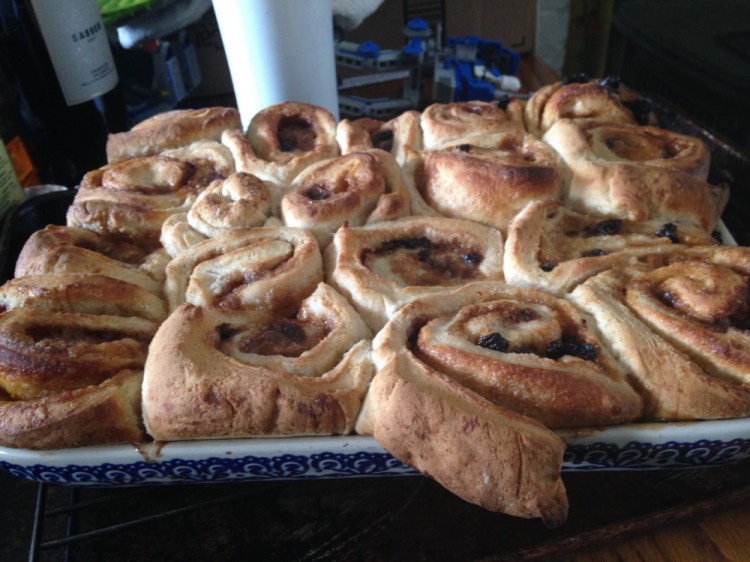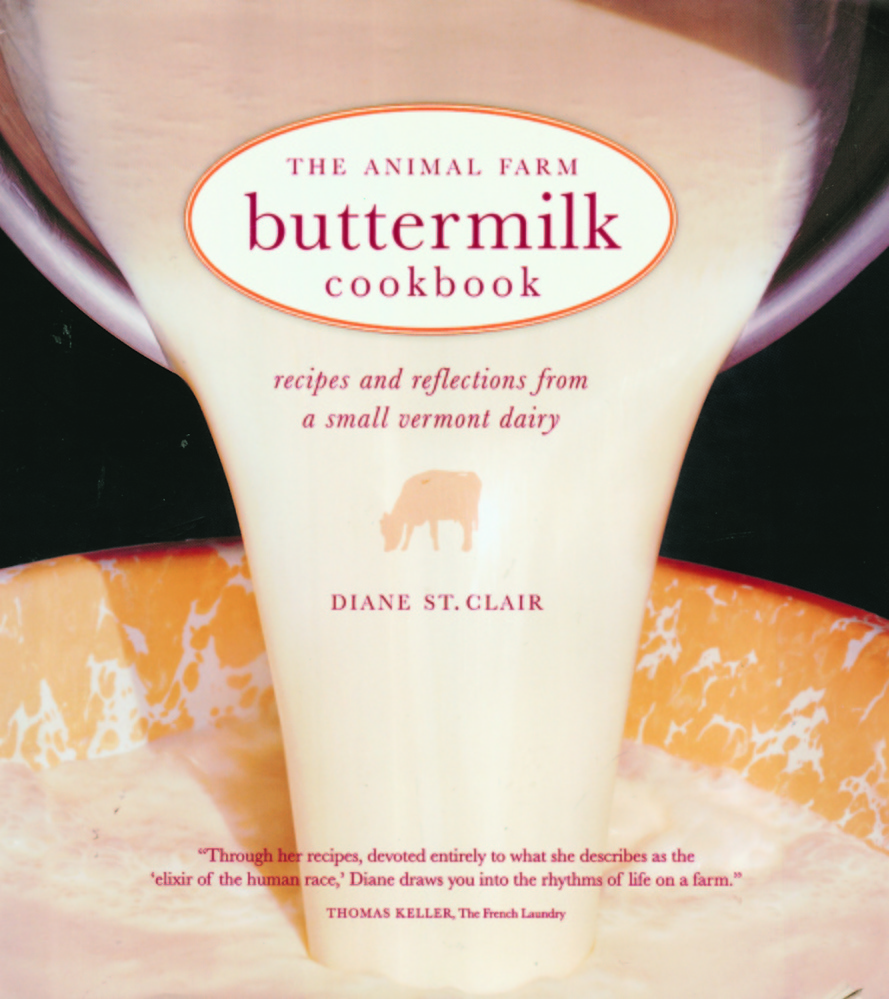Single-topic cookbooks used to strike me as majorly overindulgent, like having both an entire set of All-Clad and Le Creuset. Life isn’t long enough for that many pots and pans or cookbooks that tell you everything that can be done with say, quinoa or lobster. Most of these books still seem like unnecessary products of our culture’s culinary obsession – part vanity, part a desperate grab at the marketplace. But Alice Waters’ excellent, beautifully organized “Chez Panisse’s Vegetables” opened me up to the point where I willingly acquired books with titles like “Tacos” and “Cupcakes.” (The first is useless, the second I use constantly.)
Which is one reason I was drawn to Diane St. Clair’s slim, sweet, surprisingly useful volume “The Animal Farm Buttermilk Cookbook.” I buy Kate’s Real Buttermilk whenever I’m making a birthday cake or cupcakes and even after I make a batch or two of pancakes or waffles, I have leftover buttermilk. I wanted some good ideas for that last cup or two.
The other reason is that St. Clair has been supplying two of the country’s most renowned restaurants, Thomas Keller’s French Laundry and Per Se, with fresh-made butter from her farm in Vermont for years, which means she presumably knows something about dairy and particularly buttermilk since in its original, purest form, buttermilk is a byproduct of churning butter from cream.
The text of “The Animal Farm Buttermilk Cookbook” is clear and concise, both in the recipe writing and the more educational opening chapters, though some of the recipes are so obvious a recipe hardly seems necessary. That’s what I told myself as I made her “Buttermilk Mashed Potatoes.” But one little tip – don’t heat the buttermilk before adding it to the very hot potatoes – was invaluable (the buttermilk will break and “ruin the illusion of buttery potatoes”). Her “Buttermilk Potato Cakes” cooked up like savory pancakes and were a fantastic way to use up the leftovers.
St. Clair’s Buttermilk and Proscuitto Shirred Eggs were ridiculously easy and made a pleasant, if slightly watery, dinner for me on a night when all my son wanted was a hamburger and all I wanted was something that was not a hamburger. I was much less happy with her Buttermilk Egg Salad, which had a nice tang from the buttermilk (a healthier substitute for mayonnaise) but was overwhelmed by a half-teaspoon of curry. Her wonderfully easy Double-Chocolate Buttermilk Cookies, which cook up like snowdrops, had glorious texture, crunchy and light, but were too sweet to be a regular part of my repertoire.
But the baking chapters yielded two new favorites: St. Clair’s Maple Buttermilk Sandwich bread, and the recipe that had my friends and family falling at my feet, the Orange-scented Cinnamon Rolls. These were fairly time-intensive but produced a dream cinnamon bun, with just a whiff of orange to make them interesting and a sweet dough that was soft but substantial. “I love you so much!” my son said after he bit into his first. Usually this praise is reserved for the nights when I tell him I’m taking him out for pizza. A triumph like this means I’ll keep cooking through the book. Doesn’t Raspberry Buttermilk Tart sound good? Or Shrimp and Buttermilk Grits? Onward.
Orange-scented Cinnamon Rolls
Hands down, this was the “keeper” in “The Animal Farm Buttermilk Cookbook.” I substituted 1 cup of whole wheat flour for the same amount of all-purpose, so that I could feel virtuous; it gave the dough extra heartiness. Also, since I don’t like nuts in buns, I substituted dried currants, which were delicious.
Yields 12 rolls (although I ended up with 19 rolls of varying sizes and just stuffed them all into the dish.)
DOUGH
1 cup buttermilk
½ cup unsalted butter
1 (¼-ounce) envelope active dry yeast (2½ teaspoons)
2 tablespoons light brown sugar
½ cup warm water (115 degrees F)
1 teaspoon salt
4½ cups unbleached all-purpose flour
Vegetable oil, for greasing the bowl
FILLING
½ cup unsalted butter, softened, plus 2 to 3 tablespoons more for buttering the pan
1½ cups packed light brown sugar
2 teaspoons ground cinnamon
1 cup chopped walnuts
Zest of 1 orange
TO MAKE THE DOUGH: Put the buttermilk in a small saucepan over medium-low heat and add the butter. Heat just until the butter is melted, then set aside to cool. Stir the yeast and brown sugar into the warm water, and let sit for 10 minutes, or until foamy.
Put the buttermilk-butter mixture into the bowl of a stand mixer fitted with a dough hook and add the yeast mixture, stirring to combine. Add the salt and then, with the mixer on low, add the flour, 1 cup at a time, until each cupful has been absorbed to make a soft, wet dough.
Using the dough hook, knead on a low speed for 3 to 4 minutes, to make a soft, springy dough. (Or knead by hand on a lightly floured surface for about 8 minutes.) Coat the inside of a clean bowl with a little vegetable oil, turn the dough in it to coat, and then cover the bowl with plastic wrap. Set aside in a warm place for 30 minutes, or until nearly doubled in size.
TO MAKE THE FILLING: Liberally butter a 9-by-13-inch baking dish with the 2 to 3 tablespoons additional butter and sprinkle with ½ cup of the brown sugar.
Sprinkle flour on a clean work surface and roll the dough into a rectangle about 10 by 16 inches.
Spread the softened butter over the whole surface, then sprinkle the remaining 1 cup of the brown sugar over the dough, followed by the cinnamon and nuts. Sprinkle the orange zest evenly over the whole thing. Starting from the long edge, roll up into a log. Use a serrated knife to slice the log into 12 rolls. Lay each roll flat in the prepared baking dish. Cover and let rise for 30 minutes, or until nearly doubled in size.
Meanwhile, preheat the oven to 400 degrees F.
Bake for 20 minutes, or until golden brown. Let stand for 2 to 3 minutes, then invert the pan over a serving platter. Use a heatproof spatula to scrape out every bit of the bubbling brown sugar and butter and let it drip down over the rolls.
Serve warm. Follow St. Clair’s instructions to take them over the top by frosting with a mixture of 1 cup of confectioners’ sugar and the juice from the zested orange. (Can be reheated. Actually, these can be eaten cold. They are that good.)
Send questions/comments to the editors.





Comments are no longer available on this story